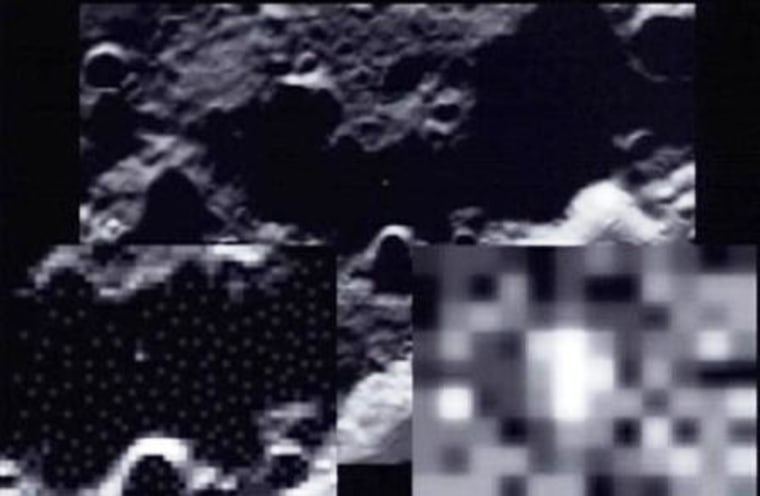Scientists said NASA's moon-smashing mission produced enough data on Friday to address questions about lunar water ice — but the crash didn't come close to meeting public expectations as a cosmic fireworks show.
"Today we kicked up some moondust, and all indications are we are going to have some really interesting results," said Pete Worden, director of NASA's Ames Research Center in California. Ames served as the mission control center for the Lunar Crater Observation and Sensing Satellite mission, or LCROSS.
The aim of the $79 million mission was to send two spacecraft — a spent rocket stage and an instrument-equipped "shepherding spacecraft" — down into a crater near the moon's south pole at about 5,600 mph (9,000 kilometers per hour) and see if the impacts threw up water ice. Recent research has confirmed the view that water ice is prevalent on the lunar surface, and scientists believe permanently shadowed craters are the best places to find such ice.
In the long term, ice reservoirs could be used to provide water for lunar settlements, as well as oxygen for breathing and hydrogen fuel for spacecraft. In the shorter term, learning about lunar water could help scientists reconstruct the ancient past of the Earth-moon system.
The LCROSS blast promised to show how much water ice might lie within a cold, dark crater known as Cabeus. And judging by that scientific standard, members of the LCROSS team said Friday's closely observed crash was shaping up as a smashing success. The spacecraft hit the crater in a shadowed area, just as hoped. All of LCROSS' instruments appeared to be working as expected, and observations were streaming in from a network of ground-based telescopes monitoring the impact.
"We got the information we need to address the question," principal investigator Anthony Colaprete told reporters.
‘I can’t see anything’
But the mission was also touted as a spectacle that could be watched from ground-based observatories and even through medium-sized backyard telescopes. On that score, the event was less impressive. Many people who expected to see an awesome blast came away disappointed.
"I was hoping we'd see a flash or a flare," Jim Mahon, who was demonstrating a telescope at Los Angeles' Griffith Observatory, told The Associated Press.
"I can't see anything," TODAY host Matt Lauer said during NBC's live coverage of the crash.
Colaprete acknowledged that he expected to get a better visual fix on the crash and the resulting debris plume, but he emphasized that scientists were still analyzing the data. He speculated that the probe might not have thrown up as much material as expected because it hit a patch of soil that was prone to compression, or because the force of the blast was directed sideways rather than upward.
"Stay tuned," he told reporters. "I certainly hope we can dig something out of there that will be telling."
Climax of months-long mission
LCROSS was launched in June along with a bigger NASA satellite, Lunar Reconnaissance Orbiter, and for months mission planners counted down toward Friday's double-barreled crash. LCROSS' 2.2-ton Centaur rocket booster, which separated from the main spacecraft on Thursday night, was the first to hit the Cabeus crater at 7:31 a.m. ET.
The 1-ton shepherding spacecraft followed behind, sending back real-time imagery in multiple wavelengths as it approached the impact site. Four minutes after the Centaur crashed, LCROSS itself cratered into the moon — providing another potential set of observations.
Before the crash, experts expected the Centaur to create an impact crater about 66 feet (20 meters) wide. After the event, Colaprete said infrared imagery from the LCROSS shepherding spacecraft showed a blip of heat from a crater that appeared to be about as big as expected. "We actually saw a crater; we measured its temperature," he said.

Experts also expected the impact to kick up a plume of debris rising as high as six miles (10 kilometers) above the lunar surface. Colaprete said no signs of such a plume had yet been seen in preliminary data from LCROSS or ground-based telescopes. However, other scientists reported that Lunar Reconnaissance Orbiter detected the plume’s spectral signature as well as evidence of the crater. The LCROSS team was also waiting for spectral data from the Hubble Space Telescope.
Those spectral readings would be crucial for conducting a chemical analysis of the impact debris and figuring out how much water, if any, might be hidden in the shadowed crater. "The spectra is where the science is," Colaprete said.
Even if the LCROSS readings don't turn up evidence of water, that wouldn't necessarily mean the water isn't there, said Michael Bicay, director of science at Ames. Ice might be distributed unevenly in the crater, and LCROSS might have hit just the wrong place for water.
"We may have hit a dry hole rather than a wet hole," he said.
One reporter asked Colaprete whether he would know by the end of the day whether LCROSS kicked up any fresh evidence of water on the moon. "I probably will," Colaprete answered, "but I'm not going to tell you."
Colaprete said he expected the data analysis to take two months or so, and suggested that the mission's initial findings might be announced in San Francisco during a meeting of the American Geophysical Union in December.
More on LCROSS | Lunar Reconnaissance Orbiter